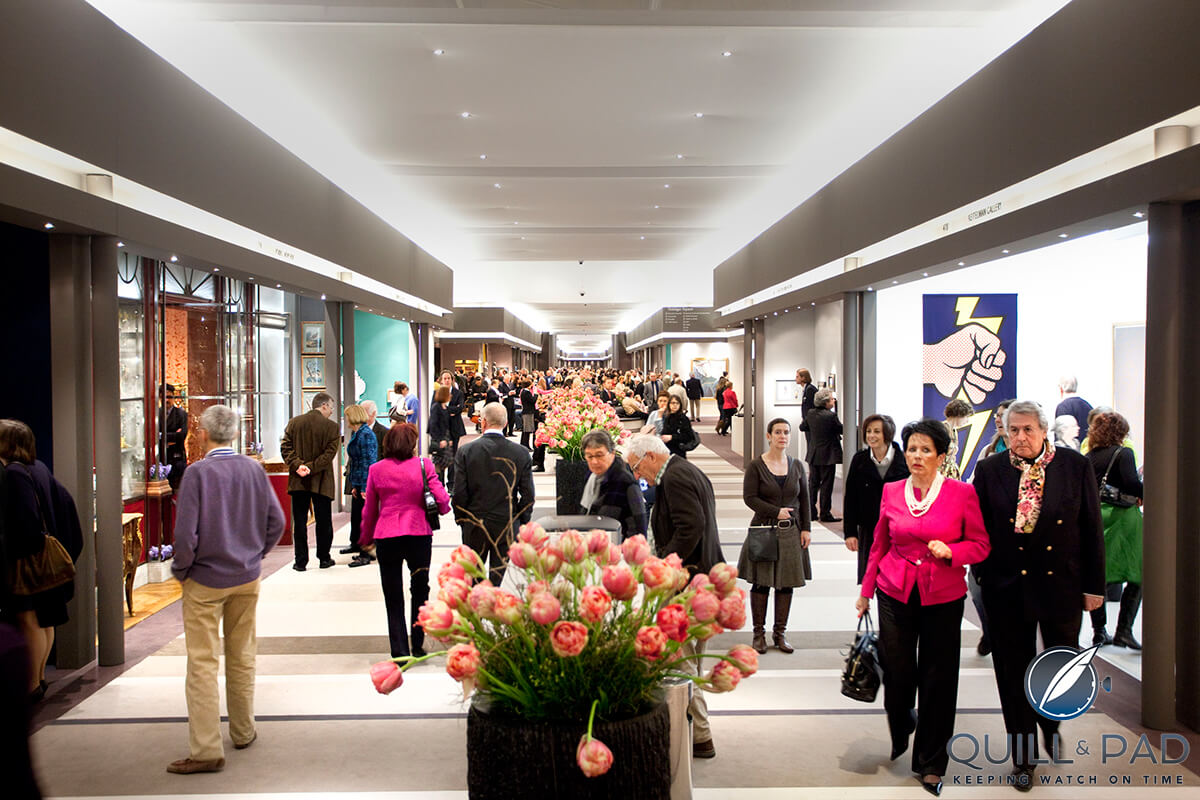Entering Mentink & Roest’s booth, one is not only immediately enchanted by the lovely chimes and ticks of timepieces that are hundreds of years old. Here at this booth planted squarely within The European Fine Art Fair (TEFAF) held in Maastricht, Holland, the senses are also barraged by the conversations taking place among the various connoisseurs, collectors and dealers of these pieces, all of whom seem to know each other so well.
You see, this is the TEFAF, certainly the premier fair for art and antiquities in the world, a place where “old Europe” meets new nobility, all in search of extraordinary artifacts and objets d’art to beautify the home and investment portfolio.
And here at this booth is where my host for the day, Dr. Helmut Crott, dealer in antique timepieces and now owner of Urban Jürgensen & Sønner (UJ&S), converges with a number of longtime friends and business acquaintances in an annual ritual that each one of them looks forward to like no other event in the horological scene.
Time stands still
These men might be accurately described as the premier experts and dealers in seventeenth- and eighteenth-century timepieces today. A friendly, convivial group, they visibly light up when they see each other to exchange old stories and new gossip. As Crott and I walk past a large Empire-era clock, he eyes it with longing.
But he continues past it – likely filing the information to come back to later in the fair – as he spies his old friend Andrew Crisford. He is almost nervously excited as he introduces me, but then so am I. Crisford is a legendary figure in our little world of ticks and tocks: a past master of the Worshipful Company of Clockmakers, founder of important dealer in antiquarian timepieces Bobinet, and longtime friend of the late George Daniels.
A different kind of vintage
While today, a different kind of vintage has become all the rage, primarily thanks to the good work of high-profile auctions like Christie’s Rolex Lesson One and Ben Clymer over at Hodinkee, Crott and his posse deal in timepieces not likely to be affected by trends and fashions. These are timepieces that represent eternity with their opulent visuals, artistic symbolism, groundbreaking technology and proclivity toward simply remaining static. These pieces can’t necessarily be worn, nor do they bow to the whims of the strap du jour.
These jovial gentlemen tell tales of bygone days, of beginnings in a scene that would be deeply affected by the decade-long sovereignty of inexpensive, yet ultimately ultra-precise quartz movements mass-produced in Japan. They were also an inadvertent, intrinsic part of the ensuing mechanical renaissance, whether they knew it at the time or not.
Work completed by Crisford, Daniels and others has gifted us with literature filled with historical precisions concerning Abraham-Louis Breguet and other important horological masters. They continue to aid prominent auction houses in propagating the beauty of vintage timepieces with their encyclopedic knowledge.
Another of the illustrious regulars at Crott’s table had also interestingly crossed the line from vintage antiquity dealer to behind-the-scenes maker of early Swiss complications in the mechanical renaissance. Though Simon Bull’s name may not be a household one, some of the beautiful mechanics he helped create within the last 30 years as a previous director of Techniques Horlogères Appliquées SA (THA) in Sainte-Croix certainly are household names among connoisseurs and collectors. One such beauty is, for example, the Breguet resonance clock.
Continuing history
The convivial Crott, of course, founded Germany’s premier auction house, Dr. Crott, in the 1970s. He sold it two decades later, and it remains the top destination for quality auctions in Germany.
Crott, Crisford, et al also shared knowledge with some of the younger stars of today’s vintage scene, men such as former head of watches at Christie’s Aurel Bacs and Arnaud Tellier, former curator of the Patek Philippe Museum. Though vintage timepieces of this ilk seem to have fallen out of fashion, the quality of the next generation of experts is thankfully secured.
Today, Crott continues the legacy of Urban Jürgensen & Sønner following the death of Peter Baumberger in 2009, who had successfully sustained the high quality of the brand’s name and rare products in the wristwatch era as from 1979.
The pairing with Crott could not be more ideal; UJ&S’s entire philosophy is rooted in the history of timekeeping. I believe it takes someone with such an innate understanding of where it came from to be able to lead it successfully into a new future. A future I believe we can all look forward to if the past three years are any indication.
What was Crott wearing on his wrist during our day at the TEFAF, you ask? Sorry, I can’t tell you just yet. But if you watch our site carefully over the next fortnight, you’re bound to see us reporting on it. But what I can do is give you a little preview (above).
The TEFAF opened on Thursday, March 13 with a day only for invited guests and press. The fair, open to the public, will continue to run until March 23, 2014. For more information, please visit www.tefaf.com.







Leave a Reply
Want to join the discussion?Feel free to contribute!